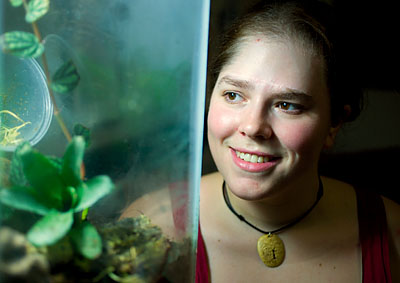Frog in Her Heart
When Taegan McMahon ’07 drives home to Noank, Conn., she turns on the seat heater for Tink, her companion. He likes it, she says.
Tink, however, is silent on the topic. Like many of his species — Dendrobates tinctorius, a poison dart frog — he’s a bit shy. So even though McMahon chats him up on the way home, Tink prefers to hide under a log in his tank, munching fruit flies.
More than just an inch-and-a-half pet, Tink symbolizes McMahon’s longtime zeal for dart frogs and their habitat, the rainforests of Central and South America, two passions that form the basis for McMahon’s year-long biology thesis: studying the effect of acid rain on the health and growth of one of Tink’s cousins, Epipedobates tricolor.

Taegan McMahon ’07 surveys her frogs’ habitat in her Nash House room.
McMahon got the bug for frogs more than a decade ago, when she and her fellow second-graders raised $50 in returnable bottles to save two acres of Costa Rican rainforest (in fact, the project’s cofounder was Bates biology professor Sharon Kinsman). McMahon went further than her classmates, ponying up money earned from selling handmade clay-and-bead jewelry. Two years later, her family traveled to Costa Rica, and McMahon was able to hike through “her” land.
As an offshoot of their Costa Rica trip, McMahon and her mother, Diane Hitchcock, began raising dart frogs at home (they’re not poisonous when raised in captivity). “They are very high-maintenance, but they are very cool and absolutely beautiful,” she says. “And they are a bold frog. A lot of frogs, like the green tree frog, just sit there and do nothing. But these guys jump and climb around. They are comical, very entertaining.”
By the time she was a sophomore at Bates, McMahon knew she wanted to study them for her senior thesis, which is why a couple dozen egg-producing adults live in various tanks in her parents’ living room in Noank. Also at home are two dogs, a cat, three water dragons, five leopard geckos, two day geckos, a very old tarantula, and some fish. The family horse, though, lives down the road.
Tadpoles born in Noank are now swimming about in 27 plastic beakers clustered on a warming mat in a third-floor Carnegie lab. Some live in slightly acidic water (pH 5.0), while others are in neutral water (pH 7.0), with McMahon recording the growth and activity of the itty-bitty guys, as these aren’t the pond pollywogs that make toddlers squeal. Taped to the wall above the whole setup is a handwritten sign on a piece of paper towel: “Taegan McMahon’s thesis. Do not move/disturb.”
So, McMahon’s thesis looks simple, and the premise is certainly accessible, as scientists have long believed that acid rain has played a role in the decline of amphibians worldwide. With acid rain a relatively new phenomenon in rainforest environments, McMahon’s work is potentially valuable, says her thesis advisor, Ryan Bavis, assistant professor of biology.
But executing the project has involved typical senior-thesis steps and missteps. “She even had to make her own water,” Bavis says. When introduced to tap water, the first batch of test tadpoles died. McMahon now uses deionized water that flows into the lab from a holding tub atop Carnegie. Even adjusting and maintaining the water’s pH was hard. She found that “water doesn’t ‘want’ to be at a low pH.”
“Dealing with technical issues is part of the education you get doing an experimental senior thesis,” Bavis says. And while not an amphibian expert, he is giving McMahon something more important than topic-specific advice. Like other professors with their seniors, he’s teaching McMahon to have the mindset of a scholar and scientist, rather than simply being an advocate for one untested idea or another.
“You have to be confident that the effect you see, positive or negative, is truly positive or truly negative,” he says. “You have to be able to trust your results, trust that you don’t have flaws in your experiment.”
For McMahon, these academic lessons will focus a powerful, homegrown spirit of environmental inquiry.
Diane Hitchcock recalls how her own mother, way before Rachel Carson’s Silent Spring awakened environmentalism in the ’60s, “was sure we were ruining our environment. She was growing our own food, washing and reusing paper towels, and composting garbage. That’s where Taegan gets a lot of her compulsion about sustainability.” (Taegan’s brother, Kelton ’05, inherited some too: he’s a Ph.D. candidate in ecological geochemistry through MIT and Woods Hole.)
Inside McMahon’s small single in Nash House, a theme house devoted to folk arts, music, and culture, is more evidence that she focuses on the big picture. Besides Tink in a tank, you see musical instruments, pictures, and various quotes (“In the end, our society will be defined not only by what we create but by what we refuse to destroy,” from the Nature Conservancy).
And there are tapestries, from Tanzania, Australia, Nicaragua, and Costa Rica. “I try to bring parts of the world to where I live,” McMahon says.
Freelancer Elissa Bass ’85 wrote the stories for the “Five Years Later” feature in the Fall 2006 issue of Bates Magazine.